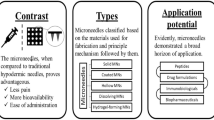Abstract
In this study, we fabricated two different microneedles (MNs) — semi-hollow and bird-bill — to overcome the limitations of solid and coated MNs, respectively. The two MN arrays were developed using a general injection molding process to obtain high-quality MNs with uniform shape. The semi-hollow and bird-bill MNs could penetrate the micropores of swine skin up to depths of 178.5 ± 27.6 µm and 232.1 ± 51.3 µm, respectively. When the semi-hollow MNs were used for the transdermal delivery of insulin in diabetic rats, it was observed that the blood glucose concentration (BGC) decreased remarkably within 30 min, and the desired effect of insulin was maintained for an additional 3 h after the removal of insulin from the skin surface. The bird-bill MN was able to load a coating gel at a maximum capacity of 3.20 ± 0.21 mg per MN array, and the BGC continued to decrease significantly after MN application for up to 2–6 h. In summary, we fabricated semi-hollow and bird-bill MN arrays using the injection molding method; these can be mass produced and are capable of effectively producing micro-holes in the stratum corneum. The two MN arrays could provide effective transdermal delivery of large-molecular-weight drugs such as insulin.





Similar content being viewed by others
Abbreviations
- MN:
-
Microneedle
- SC:
-
Stratum corneum
- TEWL:
-
Trans-epidermal water loss
- MEMS:
-
Micro-electro-mechanical system
- STZ:
-
Streptozotocin
- OCT:
-
Optical coherent tomography
- BGC:
-
Blood glucose concentration
References
S.-H. Baek, J.-H. Shin, Y.-C. Kim, Drug-coated microneedles for rapid and painless local anesthesia. Biomed. Microdevices 19, 2 (2017). https://doi.org/10.1007/s10544-016-0144-1
M.-C. Chen, M.-H. Ling, S.J. Kusuma, Poly-γ-glutamic acid microneedles with a supporting structure design as a potential tool for transdermal delivery of insulin. Acta Biomater. 24, 106–116 (2015). https://doi.org/10.1016/j.actbio.2015.06.021
Y. Chen, B.Z. Chen, Q.L. Wang, X. Jin, X.D. Guo, Fabrication of coated polymer microneedles for transdermal drug delivery. J. Control Release 265, 14–21 (2017). https://doi.org/10.1016/j.jconrel.2017.03.383
K. Cheung, T. Han, D.B. Das, Effect of Force of Microneedle Insertion on the Permeability of Insulin in Skin. J. Diabetes Sci. Technol. 8, 444–452 (2014). https://doi.org/10.1177/1932296813519720
S.N. Economidou, C.P.P. Pere, A. Reid, J. Uddim, J.F.C. Windmill, D.A. Lamprou, D. Douroumis, 3D printed microneedle patches using stereolithography (SLA) for intradermal insulin delivery. Mater. Sci. Eng. C 102, 743–755 (2019). https://doi.org/10.1016/j.msec.2019.04.063
H.S. Gill, M.R. Prausnitz, Pocketed microneedles for drug delivery to the skin. J. Phys. Chem. Solids 69, 1537–1541 (2008). https://doi.org/10.1016/j.jpcs.2007.10.059
M. Han, D.K. Kim, S.H. Kang, H.-R. Yoon, B.-Y. Kim, S.S. Lee, K.D. Kim, H.G. Lee, Improvement in antigen-delivery using fabrication of a grooves-embedded microneedle array. Sens. Actuators B Chem. 137, 274–280 (2009). https://doi.org/10.1016/j.snb.2008.11.017
T. Hikima, K. Yamada, T. Kimura, H.I. Maibach, K. Tojo, Comparison of skin distribution of hydrolytic activity for bioconversion of β-estradiol 17-acetate between man and several animals in vitro. Eur. J. Pharm. Biopharm. 54, 155–160 (2002). https://doi.org/10.1016/s0939-6411(02)00084-x
X. Jin, D.D. Zhu, B.Z. Chen, M. Ashfaq, X.D. Guo, Insulin delivery systems combined with microneedle technology. Adv. Drug Deliv. Rev. 127, 119–137 (2018). https://doi.org/10.1016/j.addr.2018.03.011
A.R. Johnson, C.L. Caudill, J.R. Tumbleston, C.J. Bloomquist, K.A. Moga, A. Ermoshkin, D. Shirvanyants, S.J. Mecham, J.C. Luft, J.M. DeSimone, Single-Step Fabrication of Computationally Designed Microneedles by Continuous Liquid Interface Production. PLoS One 11, e0162518 (2016). https://doi.org/10.1371/journal.pone.0162518
M.J. Kim, S.C. Park, B. Rizal, G. Guanes, S.-K. Baek, J.-H. Park, A.R. Betz, S.-O. Choi, Fabrication of Circular Obelisk-Type Multilayer Microneedles Using Micro-Milling and Spray Deposition. Front. Bioeng. Biotechnol. 6, 54 (2018). https://doi.org/10.3389/fbioe.2018.00054
S.F. Lahiji, Y. Kim, G. Kang, S. Kim, S. Lee, H. Jung, Tissue Interlocking Dissolving Microneedles for Accurate and Efficient Transdermal Delivery of Biomolecules. Sci. Rep. 9, 7886 (2019). https://doi.org/10.1038/s41598-019-44418-6
E. Larrañeta, R.E.M. Lutton, A.D. Woolfson, R.F. Donnelly, Microneedle arrays as transdermal and intradermal drug delivery systems: Materials science, manufacture and commercial development. Mater. Sci. Eng. R 104, 1–32 (2016). https://doi.org/10.1016/j.mser.2016.03.001
I.-C. Lee, W.-M. Lin, J.-C. Shu, S.-W. Tsai, C.-H. Chen, M.-T. Tsai, Formulation of two-layer dissolving polymeric microneedle patches for insulin transdermal delivery in diabetic mice. J. Biomed. Mater. Res. A 105, 84–93 (2016). https://doi.org/10.1002/jbm.a.35869
K. Lee, C.Y. Lee, H. Jung, Dissolving microneedles for transdermal drug administration prepared by stepwise controlled drawing of maltose. Biomaterials 32, 3134–3140 (2011). https://doi.org/10.1016/j.biomaterials.2011.01.014
C. Plamadeala, S.R. Gosain, F. Hischen, B. Buchroithner, S. Puthukodan, J. Jacak, A. Bocchino, D. Whelan, C. O’Mahony, W. Baumgartner, J. Heitz, Bio-inspired microneedle design for efficient drug/vaccine coating. Biomed. Microdevices 22, 8 (2020). https://doi.org/10.1007/s10544-019-0456-z
F. Ribet, G. Stemme, N. Roxhed, Real-time intradermal continuous glucose monitoring using a minimally invasive microneedle-based system. Biomed. Microdevices 20, 101 (2018). https://doi.org/10.1007/s10544-018-0349-6
A.M. Römgens, D.L. Bader, J.A. Bouwstra, F.P. Baaijens, C.W.J. Oomens, Monitoring the penetration process of single microneedles with varying tip diameters. J. Mech. Behav. Biomed Mater. 40, 397–405 (2014). https://doi.org/10.1016/j.jmbbm.2014.09.015
F. Ruggiero, R. Vecchione, S. Bhowmick, G. Coppola, S. Coppola, E. Esposito, V. Lettera, P. Ferraro, P.A. Netti, Electro-drawn polymer microneedle arrays with controlled shape and dimension. Sens. Actuators B. Chem. 255, 1553–1560 (2018). https://doi.org/10.1016/j.snb.2017.08.165
Y. Zhang, G. Jiang, W. Yu, D. Liu, B. Xu, Microneedles fabricated from alginate and maltose for transdermal delivery of insulin on diabetic rats. Mater. Sci. Eng. C 85, 18–26 (2018). https://doi.org/10.1016/j.msec.2017.12.006
C.-P. Zhou, Y.-L. Liu, H.-L. Wang, P.-X. Zhang, J.-L. Zhang, Transdermal delivery of insulin using microneedle rollers in vivo. Int. J. Pharm. 392, 127–133 (2010). https://doi.org/10.1016/j.ijpharm.2010.03.041
Acknowledgements
This work was supported by the Japan Society for the Promotion of Science (JSPS) KAKENHI Grant Number JP.18K12109.
Author information
Authors and Affiliations
Corresponding author
Additional information
Publisher's Note
Springer Nature remains neutral with regard to jurisdictional claims in published maps and institutional affiliations.
Rights and permissions
About this article
Cite this article
Mizuno, Y., Takasawa, K., Hanada, T. et al. Fabrication of novel-shaped microneedles to overcome the disadvantages of solid microneedles for the transdermal delivery of insulin. Biomed Microdevices 23, 38 (2021). https://doi.org/10.1007/s10544-021-00576-x
Accepted:
Published:
DOI: https://doi.org/10.1007/s10544-021-00576-x




